All great games, like all great works of fiction, are inspired creations. The lives, memories and lessons of the creators help shape the final product. Whether a story is about a young wizard or a space cowboy there is something that inspired their creation. Fighting games for example are the result of thousands of years of history. Whether the developers made conscious or even subconscious choices in the way their game looked or played the influence from real heroes and mythological monsters, actual fighting arts and even made up martial arts helped root the biggest franchises. In my previous life on 1UP I had mentioned the influence that motion pictures had on fighting game history. The longest-lived titles were heavily influenced by cult films. I often credited the 1976 film, the Master of the Flying Guillotine for inspiring the creation of Street Fighter II and Mortal Kombat. The film introduced a tournament featuring characters of diverse martial arts backgrounds from around Asia. The template would be copied dozens of times in film, television and gaming. It was actually the sequel to the 1971 film The One Armed Boxer. That film also included martial artists of different regions fighting against each other. I even credited the 1972 film Lady Whirlwind for inspiring the creation of Chun-Li. I am here to admit that I have been ignoring a major influence on the world of Street Fighter and other fighting game franchises for a long time. For almost a decade I have failed to mention the precedence that the sensational Enter the Dragon had on the genre. I intend to spend today and the next few blogs correcting that oversight.
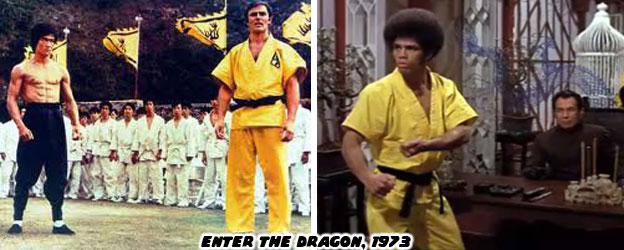
The Bruce Lee film was centered around good and evil fighters in a tournament. It predated The Master of the Flying Guillotine by three years. The characters were very diverse and reflected the international flavor that the martial arts had adopted in the 20th century. Unlike the previous films that I credited, Enter the Dragon like the Street Fighter series was set in modern times. The majority of martial arts pictures up until that point were done in China or Taiwan and were set in a classical period. Few martial arts films before Enter the Dragon featured non-Asians in leading roles. Bruce Lee inspired countless minorities and not solely Asian-Americans to pursue the martial arts. In the same way Jim Kelly became a role model for young black fighters. Lee insisted that his films break from tradition and be set in modern times. Earlier films revolved around mythological fighters and early Chinese heroes. Lee wanted to give the classic fables a contemporary retelling. He wanted to mix the gunplay and espionage from western films with the well choreographed fights from the east. He wanted to take the pictures out of the country and into the city. Lee desired to make them gritty and more realistic. Emperors gave way to drug lords and guns replaced ancient Shaolin weapons. Instead of dangling from wires Lee wanted the fights to be believable. As a result his films were incredibly original and very successful.
To help bridge the different styles of storytelling Lee had assembled a cast that reflected the west and east. Heroes and villains were equally diverse and played by both Asian and US actors. The main villain was a crime lord named Han, as played by veteran actor Kien Shih. Two of his fighters had very distinct looks to them. The muscular Bolo Yeung played Yang Sze, a bodyguard that enjoyed breaking his opponents. The wild haired Bob Wall played O'Hara. Aside from being a crazed-looking person he had a vendetta against Lee. He was scarred by Lee's sister Su Lin, as played by Angela Mao (a martial artist that helped inspire Chun-Li). Yang Sze and O'Hara were very distinct characters. They had unique features that made them stand out from the crowd. They could be considered the templates for the sub-bosses in fighting games.
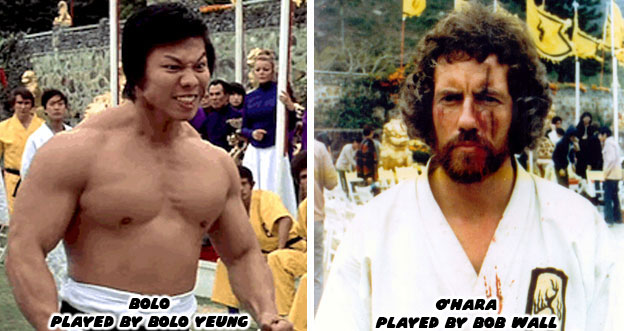
Lee had been recruited to spy on Han and try to find evidence of his illegal activities. In order to make the reliance on martial arts more believable Lee was told that guns were not allowed on the island and that was why his expertise was needed. Lee would be able to demonstrate to the world that his eastern philosophies and hybrid fighting style were the real deal. Multiple locations were filmed to create the fictional base of operations for Han. The sets would have to be large enough to accommodate dozens of extras and show off the wealth of Han. Audiences had to be convinced that the villain had enough wealth to support a small island nation. Han was in the lap of luxury and was presented in tailored suits and silk robes. He was protected by a small army of armed guards and surrounded himself with beautiful and dangerous women. His fortress and the backdrop for the tournament was a Chinese castle. He observed the tournament from a throne just above the courtyard. It framed his status and ego in equal measures. Han thought of himself as superior to the fighters he had assembled and would get a chance to show that at the end of the tournament.
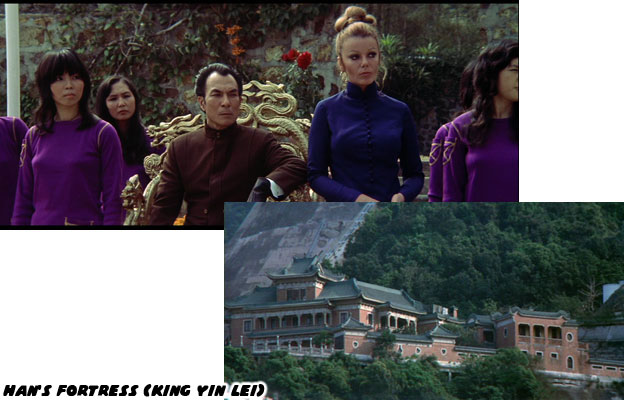
The use of a main villain overseeing a tournament from a throne would become a staple in fighting games. Mortal Kombat took several cues from pop culture including Enter the Dragon. Shang Tsung, the host of the original Mortal Kombat was not far removed from Han. His palace looked very much like King Yin Lei, the actual location used in the movie. The game series was split between the demonic "Outworld" and human world. Locations were not only exotic but also dangerous. Han's island fortress was so massive that the film could have several battles over the course of the film without having to use the same backdrop. The dragon ornaments became synonymous with Mortal Kombat, however the Bruce Lee film made use of the mythical creatures as well. Han's throne, his robes and palace were decorated with dragons. Shang Tsung officiated over his tournament, like Han, on a throne decorated with dragons.
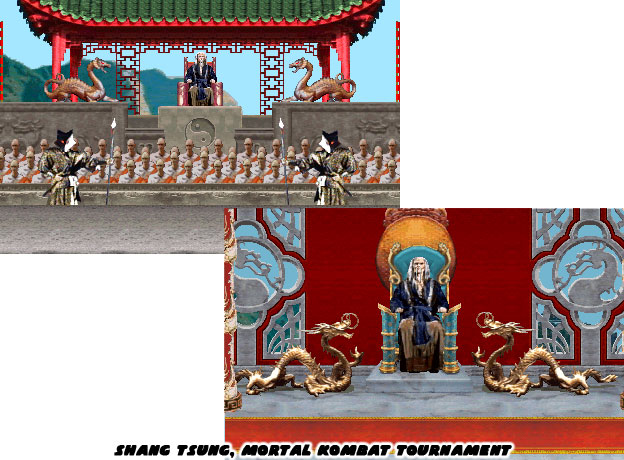
To be fair the characters in Moral Kombat and its universe were also influenced by the 1986 film Big Trouble in Little China. In the John Carpenter film the main villain was an ancient sorcerer named Lo Pan. He made up for his lack of marital prowess with magical power. Many assumed that the centuries-old character, as played by James Hong, would be easy to defeat by the much younger cast. It did not turn out to be the case as Lo Pan easily steamrolled over the heroes and villains. The twist with the villain being a capable fighter was done in both Enter the Dragon and Big Trouble in Little China. Shang Tsung would continue the tradition in the startup game. His speedy moves and powerful attacks caught many a player off guard. The game character was actually played by Ho Sung Pak. Pak. He also played Liu Kang, one of the heroes of the series. Shang Tsung had the ability to teleport and fire screaming skulls from his hands. It was a fearsome sight from a character that was supposed to hail from ancient China.
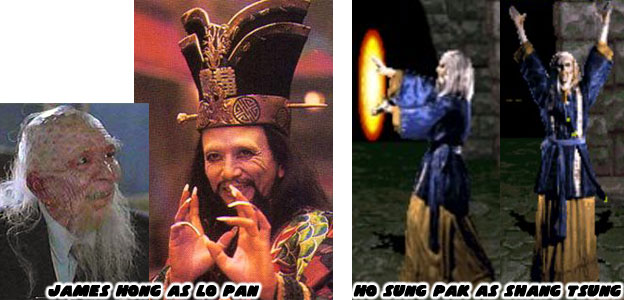
Han was a different type of villain. He did not have supernatural powers but was nonetheless dangerous. He was actually a drug lord that was a master martial artist. He had one prosthetic hand that he swapped with different hands and weapons throughout the movie. He could use the weighted metal hand to block powerful kicks, break bones and deliver lethal strikes to his opponents. When he wanted to maim an opponent he would use a hand that was an iron claw or even a hand made out of blades. The knife hand was something that undoubtedly influenced the creation of Vega / Balrog / Claw from Street Fighter II. The costume and tattoo for the Spanish matador was pulled from
San Po, the villain from the classic film Project A featuring Jackie Chan. The combination of influences from two different films with distinct villains made for a tremendous game character.
It was however the final villain of Street Fighter II, Vega / M. Bison / Dictator, and his organization, Shadowlaw, that more closely mirrored Han and the elements featured in Enter the Dragon. The next blog will look at how the film shaped the legacy of memorable stages featured in Street Fighter II.
If you would like to sponsor me
please visit my Patreon page and consider donating each month, even as little as $1 would help make better blogs and even podcasts!




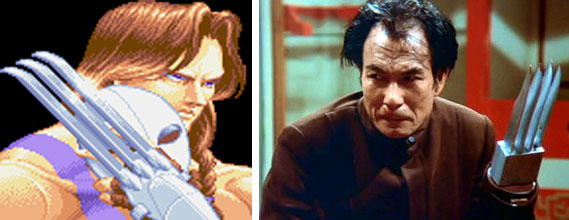

Nice one BigMex your 1st link gave me a error 404 message though.
ReplyDeleteI fixed the link, try it again please.
Deletethx Noe, all fixed good sir!
ReplyDelete